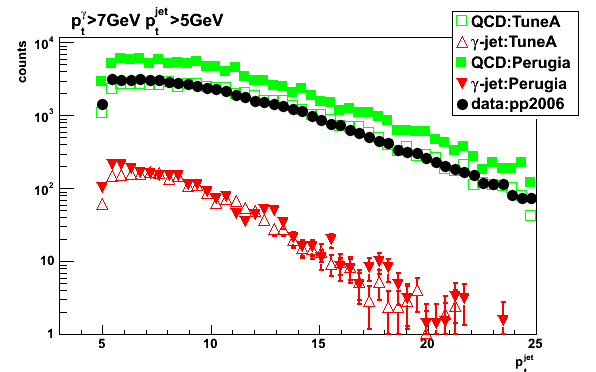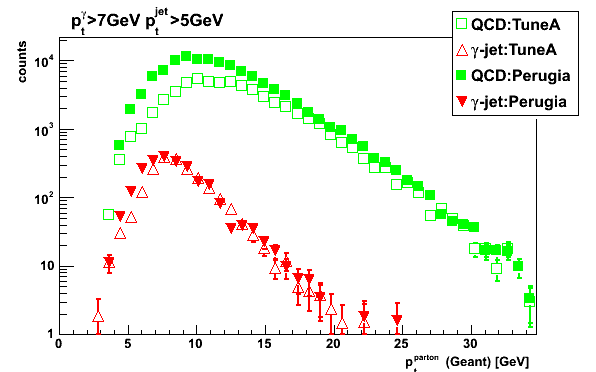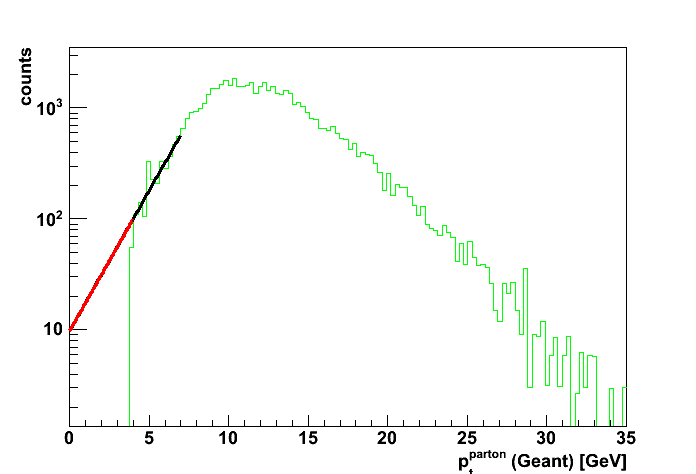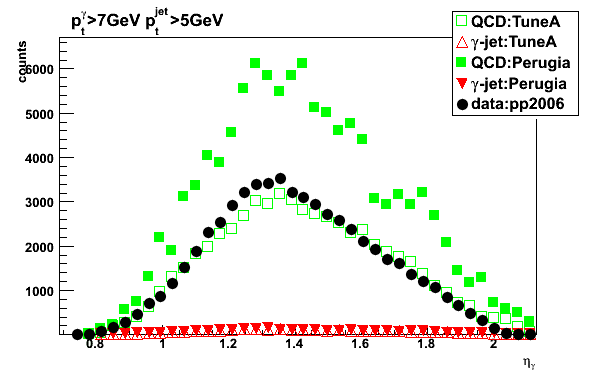2010.06.17 Pythia TuneA/Perugia0 filtered MC vs. pp2006 data
Data samples and colour coding
- black circles: pp2006 data
- open green: MC-QCD-TuneA, partonic pt 4-35
- solid green: MC-QCD-Perugia0, partonic pt 4-35
- open red MC-prompt-photon-TuneA, partonic pt 3-35
- solid red MC-prompt-photon-Perugia0, partonic pt 3-35
Event selection
- di-jets from the cone jet-finder algorithm
- photon and jet are opposite in phi:
cos (phi_gamma-phi_jet) < -0.8 - pt away side jet > 5GeV
- detector eta of the away side jet: |eta_jet_det| < 0.8
- data: L2e-gamma triggered events
- No trigger emulation in Monte-Carlo yet
- MC scaled to 3.164^pb based on Pythia luminosity (no fudge factors)
Plots before cuts on photon candidate pt
Figure 1: Reconstructed photon candidate pt, pt_gamma (no cut on pt_gamma, pt_jet > 5GeV)

Figure 2: Partonic pt distribution (no cut on pt_gamma, pt_jet > 5GeV)

Plots with pt_gamma>7GeV cut
Figure 3: Partonic pt distribution (pt_gamma>7GeV, pt_jet > 5GeV)

Figure 4: Away side jet pt (pt_gamma>7GeV, pt_jet > 5GeV)

Figure 5: Reconstructed z vertex (pt_gamma>7GeV, pt_jet > 5GeV)

Figure 6: Partonic pt distribution for Pythia CDF-Tune-A QCD simulations (pt_gamma>7GeV, pt_jet > 5GeV)
Estimate of the contribution from low partonic pt:
Black line: Exponential fit to partonic pt distribution in 4-7GeV range
Red line: Exponential fit extrapolated to the partonic pt range below 4GeV.
Ratio of the area under the red line (integral over pt=0-4GeV)
to the area under the green line (integral over pt=4-35GeV) is 0.0028 (<0.3%)

Comments
-
Simulations with Perugia0 tune has a higher yield than that from CDF-Tune-A simulations
-
Shapes vs. partonic pt are different for Perugia0 and CDF-TuneA simulations
-
Shapes vs. reconstructed variables are similar for Perugia0 and CDF-TuneA simulations
-
(based on Fig. 6) I would propose we drop both of the lowest parton pt bins,
i.e. pt=2-3 and pt=3-4 (Inherited error for pt_gamma>7GeV < 0.3%)
and instead use CPU time to produce more statistics in the 4-35 partonic pt range. -
More discussion at phana hyper news:
http://www.star.bnl.gov/HyperNews-star/protected/get/ phana/496.html
Additional figures
Figure 7a: Photon candidate yield vs. rapidity (pt_gamma>7GeV, pt_jet > 5GeV)
Left: pt_gamma>7GeV; right: zoom into eta < 1 region


Figure 7b: yield vs. jet1 momentum (pt_gamma>7GeV, pt_jet > 5GeV)
Figure 7c: eta yield without pt_gamma cut
Yields ratio for eta <0.95 to the total yield is ~ 1.7% (1004/58766 = 0.0171)
Figure 8: Photon candidate yield vs. rapidity (pt_gamma>7GeV, pt_jet > 5GeV)

Note: trigger condition is not applied in simulations yet
but at high pt the data to Pythia CDF-Tune-A ratio is about 1.28 (at 9GeV: 3200/2500),
what is consistent with an additional 25% scaling factor
used for CIPANP 2009 presentation (see slide 6)